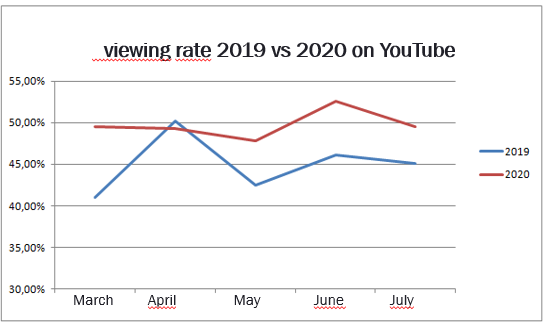Given the current situation, it is no surprise that some advertisers are moving their marketing budgets towards digital channels, with a particular focus on YouTube. In some market segments (e.g. FMCG and technologies) we observe a 30% increase in RdR budgets allocated to the largest video service in Poland. Therefore, there is no denying that the growth is substantial.
However, we must remember that the decision on where to allocate the budget should be preceded by a reliable assessment of the media results to date and their translation into business. While econometric models allowing for a long-term analysis of the impact of specific actions on sales require slightly more time (needed to collect reliable data), when analysing the current reception of our actions we can use the analysis of media results. What should be taken into account?
One of the main criteria for evaluating a campaign on YT is the so-called “view rate” – which shows how many views an advertisement has translated into “a full view”. It should be remembered what YT treats as a full view of the ad. These are: Viewing an advertisement for more than 30 seconds (for an advertisement lasting more than 30 seconds), full viewing of the shorter advertisement (including the so-called prerolls) and click on the link to the landing page.
Over the past few years, the ratio has grown from 20% in 2014 to nearly 50% at present. There are many interpretations of this change. For some, the increase is a positive factor associated with the greater awareness of the choice we want to see and don’t want to see. Some people indicate a higher share of prerolls, where the viewing rate is close to 100%. Still others raise the issue of running subsequent videos on YT in autoplay mode and broadcasting ads also before these videos, which some feel increases the chance of displaying ads even when we are not in front of the screen. This is especially important when the vast majority of films watched on YT are music that accompanies us when we focus on other tasks. Finally, the growing share of users with adblocks, i.e. people who most probably skip ads, thus reducing the analysed ratio, are not taken into account in these statistics. Which of these arguments is true? It’s hard to state decisively, probably a part of each of them. However, the fact is that Google has introduced a number of solutions that have an impact on the viewers:
- adapting ads to the YT ecosystem (e.g. suggesting skipping an ad if the recipient is not interested)
- the introduction of autoplay from Google
- the introduction of double prerolls
- increasing the total number of advertising slots during the films.
All of this makes YouTube’s ad revenue for 2019 at USD 15.15 billion globally. So, has the ongoing Covid-19 epidemic and the change to remote mode influenced how we perceive ads? Have they become less or more visible? Let’s start with some facts.

- Viewing rate – on the basis of data from selected campaigns carried out by the Publicis Groupe we can see minor year-on-year differences. We can talk about 7 percentage points on average.
- The CPV level increased YtY by 10% on average
- The number of views of YtY ads increased by 25% on average
- The number of advertisement impressions increased by 15% on average.
- The frequency of arrival per campaign remained at a similar level. (on groups all around 2-3 contacts (impressions, not views) per user).
What can we deduce from this data?
Despite much larger budgets, the CPV level of remained at a similar level. This means that we have not yet reached the maximum level of saturation with YouTube ads. The frequency of reaching the level 2-3 in the era of so many other marketing messages is low, and the effectiveness of this type of action is limited. The data does not concern Internet users with adblocks.
What do these conclusions mean for marketers, and how can they be used to evaluate the campaign?
- When planning a campaign on YT, we should start with coverage and frequency, not with the budget. YouTube is a huge, almost insatiable medium. It is possible to allocate a significant budget within the all group practically without thinking, which will not translate into building coverage and frequency. It seems reasonable to segment the all group and focus on communication around selected segments.
- The allocation criterion should be econometric research based on tracking the result according to the frequency of reach. And if this is not possible, based on previous assumptions about contact frequency. The econometric research may be influenced by limitations imposed by Google, but the Ads Data Hub platform should allow broad access to campaign data.
- Wishful thinking is that the mere fact of being on YT will essentially refresh our TG. The youngest part of the group uses adblocks or actively skips ads. It is no wonder that the most numerous group that the campaigns reach is 35-44.
- The fundamental differences in campaign effectiveness are often invisible. Why? If the CPV is PLN 0.04, then even a 10% increase will not be visible from the report level. The cost is given with an accuracy to the grosz (cent), and in this case it will be automatically rounded down. Cost analyses on tenths of a cent seem to be more and more important.
The existing ways of reporting and analysing YT activities based only on realised views are slowly becoming more and more outdated.
YouTube is a huge, horizontal platform allowing us to reach every group. However, it is necessary to plan activities in such a way that reaching it is as effective as possible.

